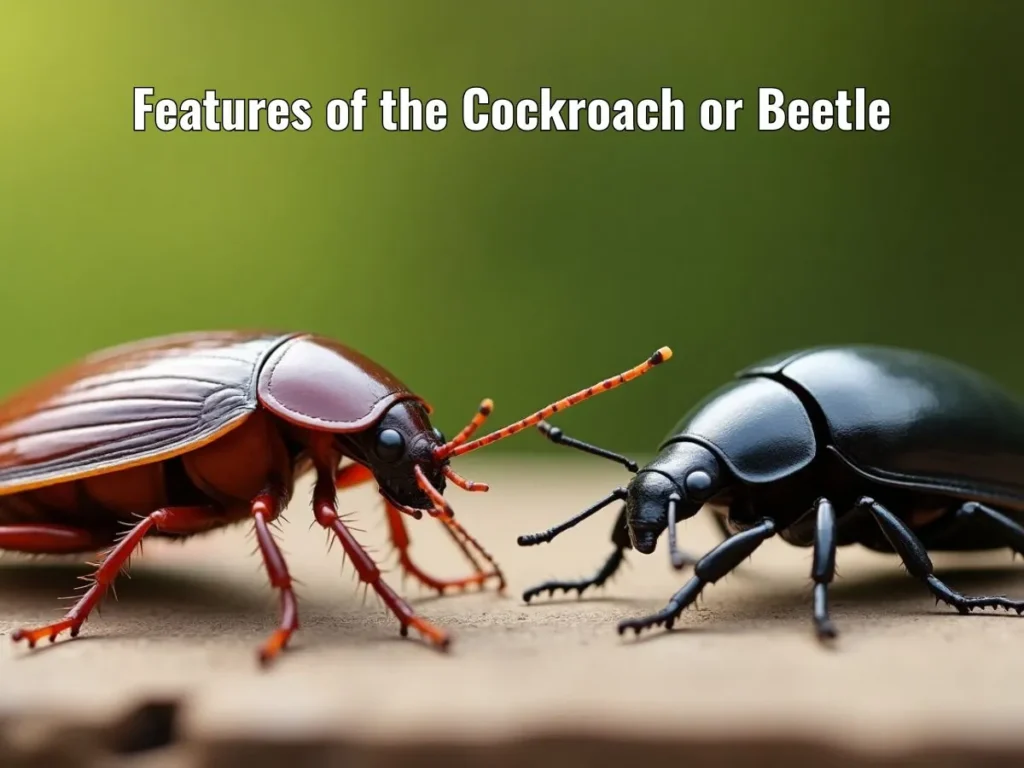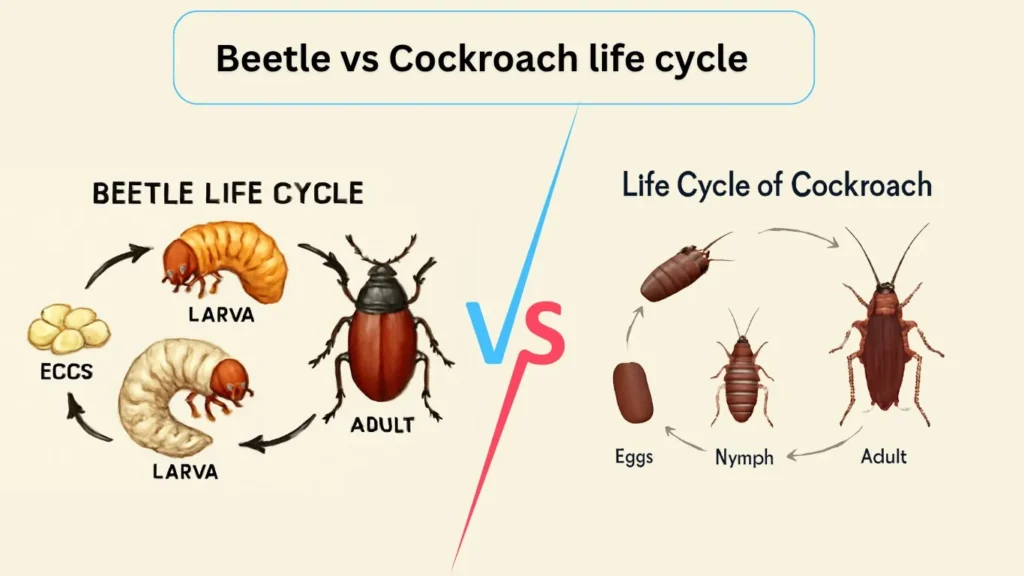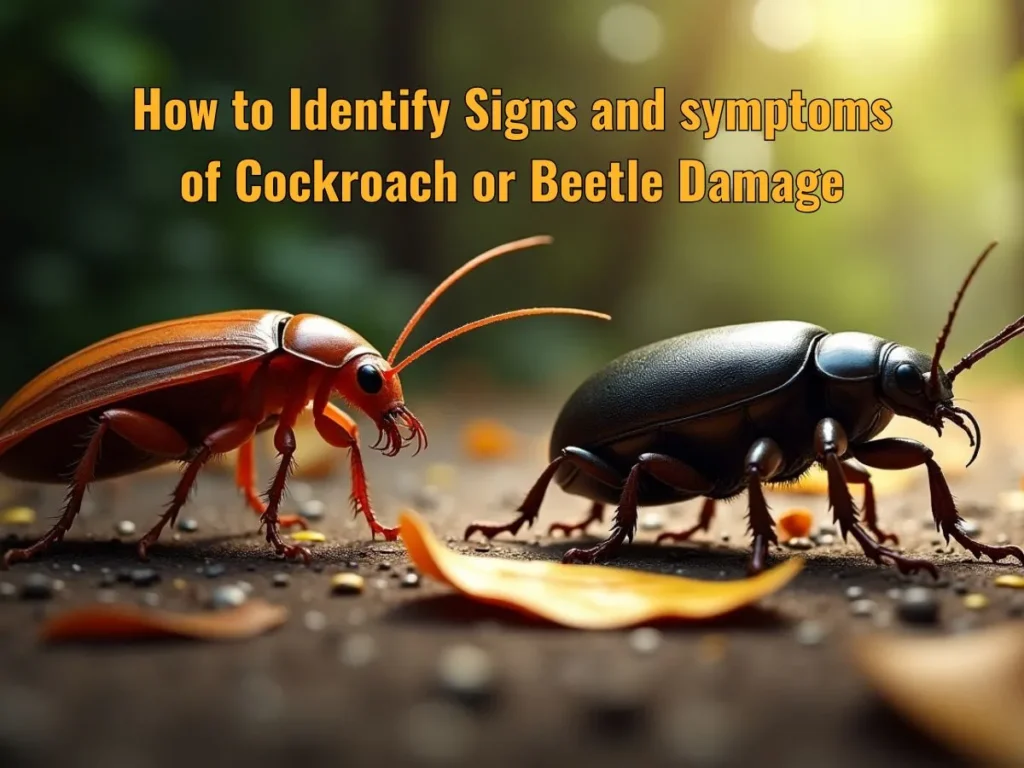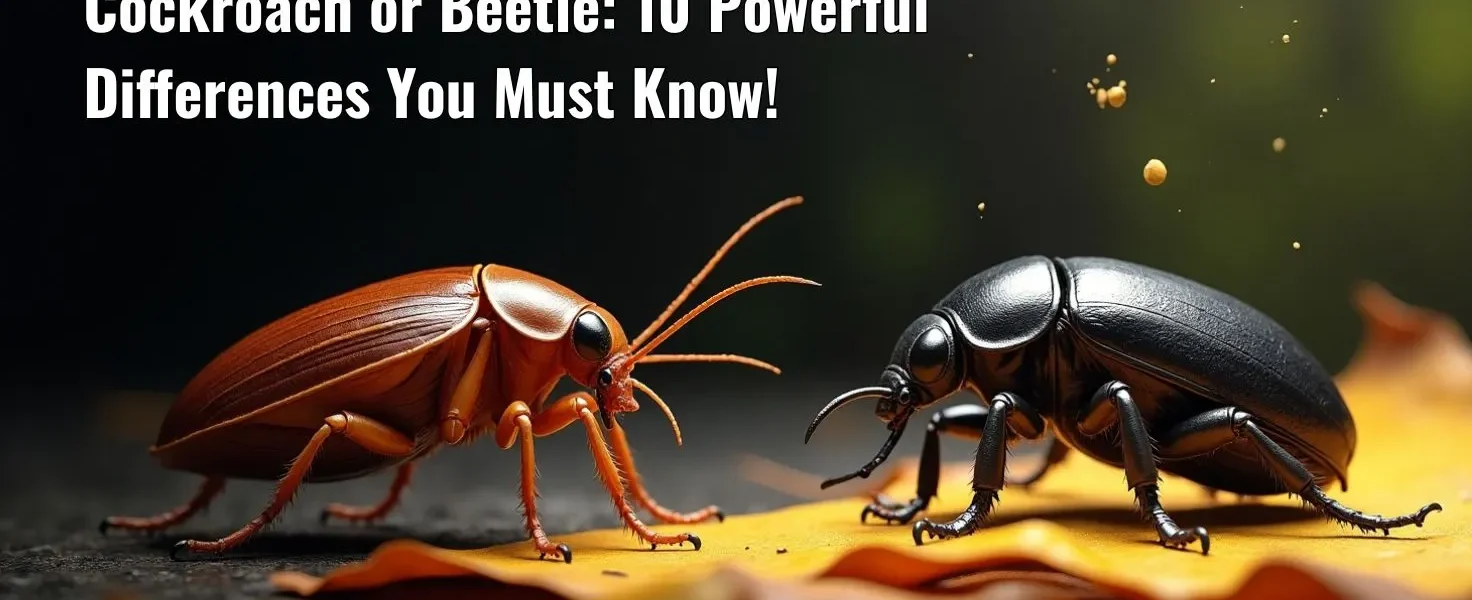All the insects are varied, such as cockroach or beetle. Neither cockroaches nor beetles are the same type of insect and cannot be combined in one group. There are two main types of bugs or insects: cockroaches and beetles.
The first time I knew and found out about insects, I thought that cockroaches or beetles had similar appearances, but I was not right. Both are insects and bugs.
Cockroaches or beetles fall in the family group of Phylum Insecta, which is the largest category of arthropods.
Features of the Cockroach or Beetle

Three-part insects, composed of three bodies (the head, the thorax, and the abdomen), with six legs, make up the cockroach or beetle.
In cockroach or beetle they consist of three pairs of legs, compound eyes, and only one antenna. Male and female cockroaches. In certain types of cockroaches, male cockroaches can have two pairs of wings, and the females none, although they are not able to fly.
How to identify Cockroach or Beetle in the house
Some species of cockroaches have males with two complete pairs of wings, whereas females do not. It is also a fact that cockroaches even have wings, but not every cockroach can fly.
Cockroaches may carry many germs and diseases that could make your family and other people in your house sick at any stage of their life cycle.
The estimated number of cockroach or beetle species in the world is about 400,000 and 4,600, respectively.
It is estimated that there are approximately 30,000 species of beetles alone in the United States, and the number of cockroach species is around 55.
10 Differences Between cockroach or beetle
1. Body and Shape
● Beetle: Their shapes are usually spheroid, round, compact, cylindrical, and tubular. Often their appearances are hard-shelled. The head is distinct from the body.
● Cockroach: Oval-shaped, flattened body (which fits and pushes itself into any crack). Their head is covered or usually hidden by a pronotum. Not so clear.
2. Size and Diversity
● Beetle: Very diverse (1mm to 15cm+). Most household kinds are 1 to 20mm. The adult baby beetle (tee, larva), is not at all similar to the adult (tee, grub/worm).
● Cockroach: As adults, typically 10 to 50mm. One of the most common household pests, such as German roaches, is 13 to 16mm. The young cockroaches (nymphs) resemble miniature, undersized adult versions without wings.
3. Color Variations in Cockroach or Beetle
● Beetle: Various colours such as reds, browns, blacks, metallic, iridescent patterns, and other bright colours. It may be a cockroach or a black beetle, although beetles are more diverse.
● Cockroach: Usually black, reddish-brown, tan, or brown. Generally dull, homogeneous colouring. The home invaders are of German and American origins and tend to be of light to medium brown colour.
4. Antenna: Unique Features and Structure
● Beetle: These are pretty different from each other because they have threadlike antennae that are hooked (with a knob at the end) and are either fluffy or saw-toothed. Normally perpetuated.
● Cockroach: Cockroaches have thinner, sharper, longer, and thread-like antennas. Most of the time, their body sizes are usually longer. Being utilized in detection and constantly in motion.
5. Forewings structure and function
● Beetle: The hardened, shell-like front forewings (elytra) overlap and cover the membranous hindwings (where they exist) and run on in a continuous line along the back and join together.
● Cockroach: The forewings and the tegmina are also equally complex and leathery, overlapping. These are made up of the hindwings rolled up and membrane covered below in a vane-like shape. Additionally, not all of them fly well.
6. Cockroach or Beetle: Preferred Environments
● Beetle: In gardens, backyards, woods, behind or under tree barks, in front of lights, pantries, carpets, and sometimes basements. Less likely to be directly associated with dirt than roaches.
● Cockroach: Such as basements, bathrooms, kitchens, drains, sewers, under and behind appliances in the home, which are dark, warm, and damp, and are located close to water and food sources. Most of the time, when you have a single cockroach in your house, you have a bug problem.
7. Leg Structure of cockroach or beetle
● Beetle: Beetles have useful legs for digging, moving, and walking. Some spines are commonly present. Not famous for going very fast.
● Cockroach: long and brown spiny legs that are especially designed to run, sprint, or scuttle. Their body structure is designed to hit, smash, and crash through the holes and cracks.
8. Movement Patterns of cockroach or beetle
● Beetle: Beetles are mostly walkers and strollers. Some of them are burrowers or excavators. Every species’ movement and flight is quite different. Beetles’ movements are slower and cautious compared to roaches.
● Cockroach: They are mindful and move at their highest speed when upset. They try to escape, and they would like to run or fly away. They can fly (better or worse, depending on the species), but their primary defense mechanism is to run.
9. Behavior: When and Why They Come Out
● Beetle: Changes in activity occur during the daytime, at night, and dawn or early morning. When their food sources or food supplies become disturbed, a lot of pest beetles come out of their hiding places
● Cockroach: Particularly nocturnal. They hide during the daytime. They leave their residences at night to hunt and search for food and water. When they are present during the daytime, it usually indicates that there are a large number of them in the population.
10. Life Cycle of cockroach or beetle

Ground Beetle or black beetle vs. Cockroach: Identification Cockroach or Beetle
| Feature Ground Beetle (Carabidae) Cockroach (Blattodea) | ||
| Body Shape | Look different, smooth, narrow, and their head separate from the body | Flattened and compressed oval with head hidden or shielded behind pronotum |
| Color | They usually are glossy black, however some of these are iridescent or copper | Different from others, American that are red-brown and some are German (tan) |
| Wings | Hard elytra (their wings are covered) and they meet in straight line | Leathery forewings overlap; Oriental females have tiny useless wings |
| Antennae | shorter or less than their body, like Thread-shaped | Elongated, Long, thin, and some have slim often longer than body |
| Legs | Long, built for running; spiny | Long, serrated and spiny that are optimized for quick scuttling |
| Movement | Fast runners and quick movements, some rarely fly | they are very fast and swift scuttlers; some fly like Americans |
| Habitat | In the wild or out of doors: they lives under piles of logs, stones, gardens and sometimes they enter homes | Indoors in home: kitchens and bathrooms, drains (German) and basements, sewers (Americans or Orientals) |
| Behavior | They are carnivores or predators (nocturnal) and they mostly eat pests like slugs, night worms and insects | Scavengers, they eat or feed on garbage and organic matter ( nocturnal) |
| Threat to Humans | No. They are useful and beneficial like pest control at home. They are harmless and non toxic | Pests: they spoil food by contaminating it, result in the allergies reactions, and they are musty as well. |
Two types of Beetles
1. Ground beetle and cockroach:
Cockroaches hunt in wet places and dark areas, while ground beetles prey on other insects and inhabit the ground.
2. Black beetle and cockroach:
Cockroaches are larger, with sharp antennae and a more flattened, rounded body. In contrast, black beetles are small, dark-colored insects typically found in homes and buildings.
Difference between GERMAN COCKROACH, AMERICAN COCKROACH, and ORIENTAL COCKROACH
| Feature | German Cockroach (Blattella germanica) | American Cockroach (Periplaneta americana) | Oriental Cockroach (Blatta orientalis) |
| Size | Small (13–16 mm) | Largest (35–40 mm) | Medium (20–30 mm) |
| Color | Light brown/tan with two dark stripes on the pronotum | Reddish and brown with yellowish contrast margin on pronotum | Oily black and dark brown to glossy and shiny black like inky or waxy |
| Wing | Both sexes fully winged (rarely fly) | Both of the sexes fully winged (males can fly short distances) | Females have tiny wing stubs that are non-functional Males: Short wings (cover ¾ of body) |
| Speed | Extremely fast | Very fast | Slow-moving |
| Preferred Habitat | Indoors (warm areas) Bathrooms, Kitchens, indoor and around home appliances | Damp areas Basements, sewers, drains, boiler rooms | Cool/damp areas Basements, crawl spaces, leaf litter |
| Odor | Mild musty smell | Musty odor | Strong, robustic, sickly-sweet “rotten” odor or smell |
| Egg Case (Ootheca) | Light tan, carried by female until hatching | shedding, Dark red-brown, and laid near food sources or supply | dropped early, Dark red-brown |
| Eggs per Case | 30–40 | 14-16 | 16–18 |
| Nymphs (Babies) | Small (pencil size) dark brown having tan stripe on their bac | Reddish-brown, wingless | Dark brown/black, wingless |
| Lifespan | Adulthood (2–6 months) Fast Breeding | Adulthood 6–12 months | Adulthood (1–2 years)Slowest Breeding |
| Infestation Risk | Highest fast reproduction and rapid growing, very difficult to eliminate them | High (especially in sewers/drains) | Moderate (slower breeding) |
How to Identify Signs and Symptoms of Cockroach or Beetle Damage

Damage Caused by Cockroaches:
- Musty, smelly odor and black, oily smudges and scratches on surfaces, walls, and other things.
- Shredded, bitten, and chewed stuff, such as cardboard, cloth, and paper, often leaving behind egg shells and colonies.
Damage Caused by Beetles:
- Different holes or irregular structures in carpets, textiles, and wood, particularly when wood-boring insects are present.
- Separate grainy dust around wood or cloth and fabric that has been damaged.
PREVENTION
Some of the following preventions from Cockroach Damage:
- Mend and seal the holes and cracks around the windows, doors, and wiring pipes and cables.
- Food items should be kept in sealed containers, and spills and other crumbs should be cleaned up as quickly.
Prevention of Beetle Damage:
- Everything, including all food and kitchen items, should be kept in airtight containers or sealed bags. Additionally, wooden furniture that bugs can infest should be inspected for signs of infestation.
- Clean areas that are open to beetle movement, such as wood cracks, and vacuum carpets regularly.
Conclusion
Cockroach or beetle are both considered common household pests; they have different appearances, behaviors, and habitats. Cockroaches are faster, sometimes resulting in health problems due to their contamination of food and the spread of many diseases.
Beetles are not always harmful to humans. Some beetles are even helpful in eliminating pests. The facts about their main differences (in body shape, locomotion, and habitat type) can empower homeowners to recognize and effectively manage such pests.
To reduce the level of infestation and prevent damage to properties, it is essential to take appropriate measures, including closing holes, maintaining proper cleanliness, and storing food in adequate conditions.
This accurate information, correct knowledge, and preventive and proactive measures can help maintain a healthy, pest-free living environment.
FAQs:
Is that a roach? If so, how can I know?
The roaches can be identified by their brown or black color, they have long and sharp antennae, and flat, round, or oval bodies. They are fast-moving insects that mostly prefer wet, dark places and move quickly.
Do black beetles belong in the category of roaches?
No, they are not roaches. Neither are they another species of insect, like the black beetles, which are also a form of the beetle.
How do beetles look?
Heavy exoskeleton, long and pointy antennas, as well as different shades and colours. Beetles are small in size, black, and some species have vibrant and bright colours.
Do cockroaches bite or attack?
Actually, yes, but it happens very rarely. Cockroaches can bite and attack. In cases where they feel threatened or there is a matter of food or lack thereof, they may bite or attack.
What do cockroaches have as their scientific name?
The Blattella cockroach, scientifically referred to as Blattella germanica, is commonly known as the German cockroach.








